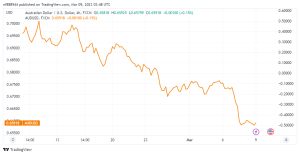In Thursday’s Asian trade, the AUDUSD is maintaining its range play below 0.6600. Despite a small retreat in the US Dollar, the pair’s gain is being limited by weaker-than-expected Chinese inflation statistics. The cautious market sentiment is also weighing on the Australian pair. The AUDUSD is trading around 0.6600 ahead of the Asian session, close to the three-month bottom of 0.6566 (March 8 low) and distant from Wednesday’s high of 0.6628. The tendency is for additional losses, with the next critical support around 0.6535. If tested over the following several hours, the specified region is predicted to hold. A break below might set up more stops, exposing 0.6500.

The 4-hour chart shows the RSI remaining oversold. A consolidation over 0.6630 might indicate a more severe correction. However, prognosis for the Australian dollar remains unfavorable if it falls below 0.6700.
Support levels: 0.6565 0.6530 0.6500
Resistance levels: 0.6630 0.6655 0.6695
In February, China’s CPI fell to 1.0% year on year, while PPI fell to -1.4% year on year.
China’s headline Consumer Price Index (CPI) fell to 1.0% year on year, down from 1.9% predicted and 2.1% before. While the Producer Price Index (PPI) fell to -1.4%, down from -0.8% previously and -1.3% market expectation. Aside from the disappointing Chinese inflation figures, the market’s risk-off mentality appears to be weighing on the AUDUSD price, owing to the pair’s risk-barometer status.
The risk-barometer pair is also under pressure on the downside from hawkish Fed bets and US President Biden’s budget plan.
In contrast, ahead of Friday’s budget presentation, US President Joe Biden suggests boosting the company tax from 21% to 28%. In addition, Biden wants to impose a 25% tax on billionaires and high fees on wealthy investors. The recent market attitude appears to be affected by a possible lack of acceptability and political turmoil caused by the aforementioned budget plan.
It’s worth mentioning that the inversion of the US yield curve keeps recession worries alive, while US President Joe Biden’s budget plan works as an additional impetus to weigh on mood and the AUDUSD market.
Yet, the benchmark US Treasury bond rates have risen for three days in a row, raising recession worries due to the biggest divergence between the two-year and 10-year bond coupons.









